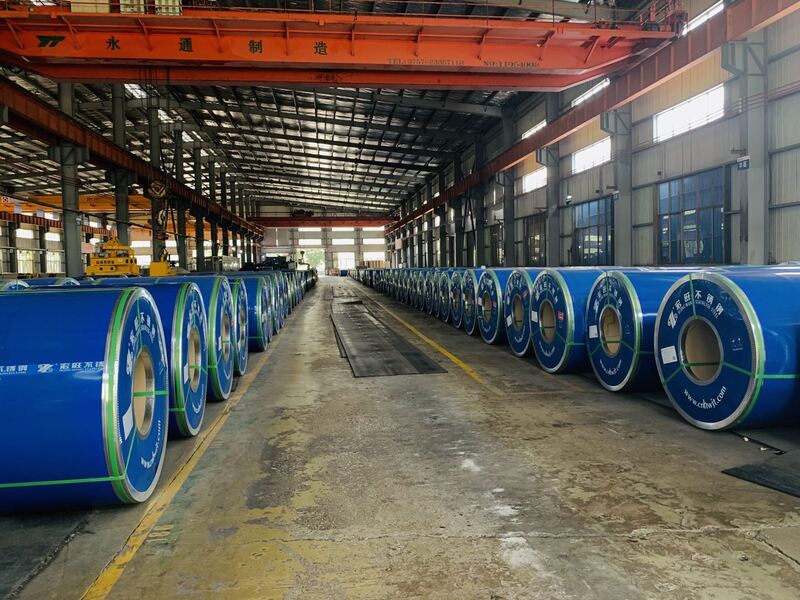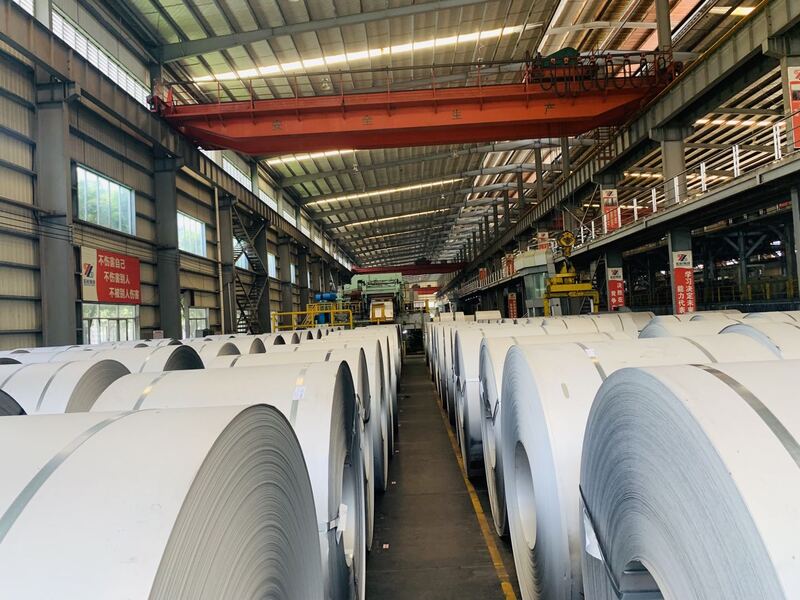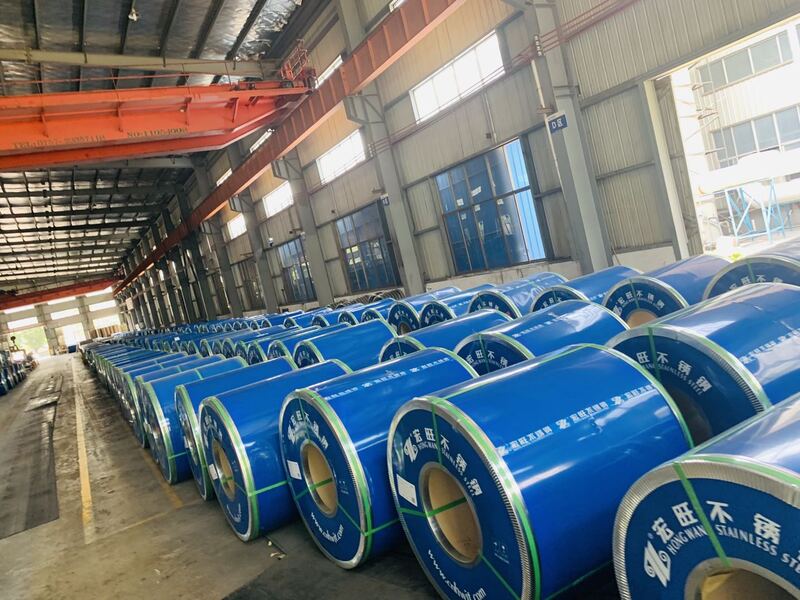
Current Location : Home > News > Industry News > Stainless steel soft material related knowledge and characteristics
Stainless steel soft material related knowledge and characteristics
Time:2021-09-23
Source:Wuxi Hongwang
Hits:640
Overview
Stainless steel soft material uses and introduction
What is the difference between stainless steel soft material and stainless steel hard material?
Why is stainless steel soft material corrosion resistant?
Maintenance and cleaning of stainless steel plate?
What are the causes of dezincification of hot rolled plate of stainless steel soft material?
The physical properties of stainless steel soft material at low temperature?

Stainless steel hard material: general material, mainly used in addition to DDQ use of materials, this material is characterized by relatively low elongation (≧ 45%), and relatively high hardness (≦ 180), the internal grain size grade between 8.0-9.0, compared with DDQ with material, its deep punching performance is relatively slightly worse, it is mainly used for products that can be obtained without stretching, such as a class of tableware spoons, spoons, forks, electrical appliances It is mainly used for products that can be obtained without stretching, such as spoons, spoons, forks, electrical appliances, and steel pipes. But it has an advantage compared with DDQ material, that is, BQ sex is relatively good, which is mainly due to its slightly higher hardness.
Stainless steel hard material: general material, characterized by relatively low elongation, and relatively high hardness, deep-drawn performance is relatively poor, it is mainly used for products that can be obtained without stretching, such as spoons, spoons, forks, appliances, steel pipes, etc.
The corrosion resistance of stainless steel sheets depends on chromium, but because chromium is one of the components of steel, the method of protection varies.
The atmospheric corrosion resistance of steel increases significantly, but with higher chromium content, the corrosion resistance is not significant, although it can still be improved. The reason for this is that alloying the steel with chromium changes the type of surface oxide to resemble the surface oxide formed on pure chromium metal. This closely adhering chromium-rich oxide protects the surface from further oxidation. This oxide layer is extremely thin, through which the natural luster of the steel surface can be seen, giving the stainless steel sheet its unique surface. Moreover, if the surface layer is damaged, the exposed steel surface will react with the atmosphere to repair itself and re-form this "passivation film" to continue to play a protective role.
Therefore, all stainless steel plate has a common characteristic, that is, the chromium content of 10.5% or more.
And building construction applications related to the steel grade usually only six. The addition of molybdenum can further improve atmospheric corrosion, especially the resistance to corrosion of atmospheres containing chlorides.
Experience shows that the degree of atmospheric corrosion varies according to the geographical area. For the purpose of illustration, it is recommended to divide the geographical areas into four categories, namely: rural, urban, industrial and coastal areas.
Industrial areas are areas where heavy industry causes atmospheric pollution. Pollution may be due to gases formed by fuel, such as oxides of sulfur and nitrogen, or other gases released by chemical plants or processing plants. Suspended particles in the air, like dust from steel production processes or deposits of iron oxide can also increase corrosion.
Coastal areas usually refer to areas within one mile of the sea. However, the marine atmosphere can spread deep inland, and even more so on islands, where prevailing winds come from the ocean and the climate is harsh. This is the case, for example, in the UK climate conditions, so that the whole country falls within the coastal zone. If the wind is mixed with marine fog, especially due to evaporation causing salt deposits to collect, coupled with little rain and infrequently washed by rain, the conditions in the coastal areas are even more unfavorable. If there is also industrial pollution, the corrosiveness is even greater.
When making a selection, it is important to determine whether there are still local factors affecting the use of the site environment. For example, stainless steel plate used in the factory chimney below, used in the air conditioning exhaust baffle near or near the scrap yard, there will be non-ordinary conditions.
The effect of rain washing was determined by placing the same slats directly in the atmosphere and in a covered area. The effect of manual washing was determined by manually scrubbing the right side of each slat with a sponge moistened with soapy water every six months. It was found that the removal of dust and silt from the surface by rainwater washing and manual scrubbing had a good effect on the surface condition compared to the slats placed in the shed area and the area that was not washed. And it was also found that the condition of the surface finish had an effect, with slats with smooth surfaces having better results than those with rough surfaces.
Therefore the interval of washing is influenced by a number of factors, the main influencing factor is the required aesthetic standards. Although many stainless steel plate curtain wall is only in the rubbing glass to wash, but, in general, for the exterior of the stainless steel plate wash brush twice a year.
(1) Stainless steel soft material of the hot-rolled plate substrate surface residual impurity particles, before dipping into the zinc pot is not removed, affecting the adhesion of the zinc layer.
(2) The substrate is accompanied by an iron oxide layer, which proves that the substrate is not completely reduced to the spongy pure iron needed for galvanizing in the annealing furnace.
(3) The low Al content in the alloy layer did not generate a reasonable Fe2Al5 alloy layer that plays a decisive role in the adhesion of the zinc layer, or this alloy layer was destroyed by the overgrown FeZn alloy layer.
Based on the above analysis, it is concluded that in order to solve the problem of zinc layer detachment, the product quality of hot-dip galvanized hot-rolled sheets should be improved from several aspects, such as improving the surface cleanliness of the substrate, ensuring the control of the atmosphere in the annealing furnace, ensuring the complete reduction of the substrate and adjusting the temperature of the zinc composition.
1, stainless steel soft material thermal conductivity
The size of the thermal conductivity of various types of stainless steel at very low temperatures varies slightly, but in general is about 1/50 of the thermal conductivity at room temperature. At low temperatures with the increase in magnetic flux (magnetic flux density) thermal conductivity increases.
2、Specific heat capacity
At very low temperatures, there are some differences in the specific heat capacity of various stainless steels. Specific heat capacity is greatly affected by the temperature, the specific heat capacity at 4k can be reduced to less than 1/100 of the specific heat capacity at room temperature.
3、Thermal expansion
For stainless steel, the size of the contraction rate (relative to 273K) varies slightly below 80k. The content of nickel has a certain effect on the shrinkage rate.
4、Resistivity
The difference in the size of resistivity between grades at very low temperatures increases. Alloying elements have a greater effect on the magnitude of resistivity.
5、Magnetic
At low temperatures, stainless steel varies with the material of its mass magnetization rate on the impact of the load magnetic field. There are also differences in the content of different alloying elements. There is little difference in the magnetic permeability of different grades.
6、Modulus of elasticity
At low temperatures, there is a magnetic transition of the ratio corresponding to the production of extreme values.
Tags: stainless steel soft material,cleaning of stainless steel plate,stainless steel soft material use
Stainless steel soft material uses and introduction
What is the difference between stainless steel soft material and stainless steel hard material?
Why is stainless steel soft material corrosion resistant?
Maintenance and cleaning of stainless steel plate?
What are the causes of dezincification of hot rolled plate of stainless steel soft material?
The physical properties of stainless steel soft material at low temperature?

Stainless steel soft material use and introduction
Stainless steel soft material: DDQ (deep drawing quality) material, refers to the material used for deep drawing (punching) purposes, which is what we call stainless steel soft material, the main characteristics of this stainless steel soft material is a high elongation (≧ 53%), low hardness (≦ 170%), internal grain level between 7.0-8.0, deep punching performance is excellent. At present, many production of insulation bottles, pots and pans, the processing ratio of its products (BLANKING SIZE / product diameter) are generally higher, the processing ratio of stainless steel soft material were up to 3.0, 1.96, 2.13, 1.98. SUS304 DDQ with material is mainly used for these requirements higher processing ratio of products, of course, processing ratio of more than 2.0 products are generally required after Several times of stretching to complete. If the extension of raw materials can not reach, in the processing of deep-drawn products, the product is very easy to produce cracks, pull through the phenomenon, affecting the finished product qualification rate, of course, also increased the cost of manufacturers.Stainless steel hard material: general material, mainly used in addition to DDQ use of materials, this material is characterized by relatively low elongation (≧ 45%), and relatively high hardness (≦ 180), the internal grain size grade between 8.0-9.0, compared with DDQ with material, its deep punching performance is relatively slightly worse, it is mainly used for products that can be obtained without stretching, such as a class of tableware spoons, spoons, forks, electrical appliances It is mainly used for products that can be obtained without stretching, such as spoons, spoons, forks, electrical appliances, and steel pipes. But it has an advantage compared with DDQ material, that is, BQ sex is relatively good, which is mainly due to its slightly higher hardness.
What is the difference between stainless steel soft material and stainless steel hard material?
Stainless steel soft material: refers to the material used for deep drawing (punching) purposes, which is usually referred to as soft material, the main feature of this material is the high elongation, deep punching performance is excellent. Can produce thermos, pots and pans, such things.Stainless steel hard material: general material, characterized by relatively low elongation, and relatively high hardness, deep-drawn performance is relatively poor, it is mainly used for products that can be obtained without stretching, such as spoons, spoons, forks, appliances, steel pipes, etc.

Stainless steel soft material why will be resistant to corrosion
Why does stainless steel soft material resist corrosion? All metals react with the oxygen in the atmosphere to form an oxide film on the surface. Unfortunately, the iron oxide formed on ordinary carbon steel continues to oxidize, causing the rust to expand and eventually form holes. It is possible to secure the surface of carbon steel by plating with paint or oxidation-resistant metals (e.g., zinc, nickel and chromium), but, as is well known, this protection is only a thin film. If the protective layer is broken, the steel beneath begins to rust and corrode.The corrosion resistance of stainless steel sheets depends on chromium, but because chromium is one of the components of steel, the method of protection varies.
The atmospheric corrosion resistance of steel increases significantly, but with higher chromium content, the corrosion resistance is not significant, although it can still be improved. The reason for this is that alloying the steel with chromium changes the type of surface oxide to resemble the surface oxide formed on pure chromium metal. This closely adhering chromium-rich oxide protects the surface from further oxidation. This oxide layer is extremely thin, through which the natural luster of the steel surface can be seen, giving the stainless steel sheet its unique surface. Moreover, if the surface layer is damaged, the exposed steel surface will react with the atmosphere to repair itself and re-form this "passivation film" to continue to play a protective role.
Therefore, all stainless steel plate has a common characteristic, that is, the chromium content of 10.5% or more.
And building construction applications related to the steel grade usually only six. The addition of molybdenum can further improve atmospheric corrosion, especially the resistance to corrosion of atmospheres containing chlorides.
Experience shows that the degree of atmospheric corrosion varies according to the geographical area. For the purpose of illustration, it is recommended to divide the geographical areas into four categories, namely: rural, urban, industrial and coastal areas.
Industrial areas are areas where heavy industry causes atmospheric pollution. Pollution may be due to gases formed by fuel, such as oxides of sulfur and nitrogen, or other gases released by chemical plants or processing plants. Suspended particles in the air, like dust from steel production processes or deposits of iron oxide can also increase corrosion.
Coastal areas usually refer to areas within one mile of the sea. However, the marine atmosphere can spread deep inland, and even more so on islands, where prevailing winds come from the ocean and the climate is harsh. This is the case, for example, in the UK climate conditions, so that the whole country falls within the coastal zone. If the wind is mixed with marine fog, especially due to evaporation causing salt deposits to collect, coupled with little rain and infrequently washed by rain, the conditions in the coastal areas are even more unfavorable. If there is also industrial pollution, the corrosiveness is even greater.
When making a selection, it is important to determine whether there are still local factors affecting the use of the site environment. For example, stainless steel plate used in the factory chimney below, used in the air conditioning exhaust baffle near or near the scrap yard, there will be non-ordinary conditions.

Maintenance and cleaning of stainless steel plate
As with other materials exposed to the atmosphere, stainless steel plates can get dirty. Future lectures will analyze the design factors that affect the cost of maintenance and cleaning. However, there is an interrelationship between rainwater washing, manual washing and dirty surfaces.The effect of rain washing was determined by placing the same slats directly in the atmosphere and in a covered area. The effect of manual washing was determined by manually scrubbing the right side of each slat with a sponge moistened with soapy water every six months. It was found that the removal of dust and silt from the surface by rainwater washing and manual scrubbing had a good effect on the surface condition compared to the slats placed in the shed area and the area that was not washed. And it was also found that the condition of the surface finish had an effect, with slats with smooth surfaces having better results than those with rough surfaces.
Therefore the interval of washing is influenced by a number of factors, the main influencing factor is the required aesthetic standards. Although many stainless steel plate curtain wall is only in the rubbing glass to wash, but, in general, for the exterior of the stainless steel plate wash brush twice a year.
Stainless steel soft material of the hot rolled plate dezincification reasons?
(1) Stainless steel soft material of the hot-rolled plate substrate surface residual impurity particles, before dipping into the zinc pot is not removed, affecting the adhesion of the zinc layer.
(2) The substrate is accompanied by an iron oxide layer, which proves that the substrate is not completely reduced to the spongy pure iron needed for galvanizing in the annealing furnace.
(3) The low Al content in the alloy layer did not generate a reasonable Fe2Al5 alloy layer that plays a decisive role in the adhesion of the zinc layer, or this alloy layer was destroyed by the overgrown FeZn alloy layer.
Based on the above analysis, it is concluded that in order to solve the problem of zinc layer detachment, the product quality of hot-dip galvanized hot-rolled sheets should be improved from several aspects, such as improving the surface cleanliness of the substrate, ensuring the control of the atmosphere in the annealing furnace, ensuring the complete reduction of the substrate and adjusting the temperature of the zinc composition.
The physical properties of stainless steel soft material at low temperature
1, stainless steel soft material thermal conductivity
The size of the thermal conductivity of various types of stainless steel at very low temperatures varies slightly, but in general is about 1/50 of the thermal conductivity at room temperature. At low temperatures with the increase in magnetic flux (magnetic flux density) thermal conductivity increases.
2、Specific heat capacity
At very low temperatures, there are some differences in the specific heat capacity of various stainless steels. Specific heat capacity is greatly affected by the temperature, the specific heat capacity at 4k can be reduced to less than 1/100 of the specific heat capacity at room temperature.
3、Thermal expansion
For stainless steel, the size of the contraction rate (relative to 273K) varies slightly below 80k. The content of nickel has a certain effect on the shrinkage rate.
4、Resistivity
The difference in the size of resistivity between grades at very low temperatures increases. Alloying elements have a greater effect on the magnitude of resistivity.
5、Magnetic
At low temperatures, stainless steel varies with the material of its mass magnetization rate on the impact of the load magnetic field. There are also differences in the content of different alloying elements. There is little difference in the magnetic permeability of different grades.
6、Modulus of elasticity
At low temperatures, there is a magnetic transition of the ratio corresponding to the production of extreme values.
Tags: stainless steel soft material,cleaning of stainless steel plate,stainless steel soft material use
Related News
Production precautions of stainless steel coils
2021-02-08304 stainless steel pipe can also transport gas? Amazing!
2021-10-21Performance Optimization and Advanced Research of Core Materials
2024-12-05Stainless Steel Development in Pharmaceutical industry
2022-08-15Stainless steel surface treatment process- beadblasting
2020-10-20Common 304 stainless steel sheet types
2020-12-24






